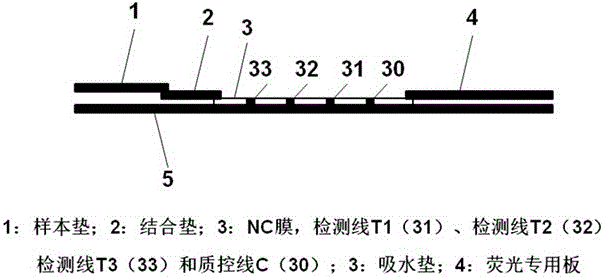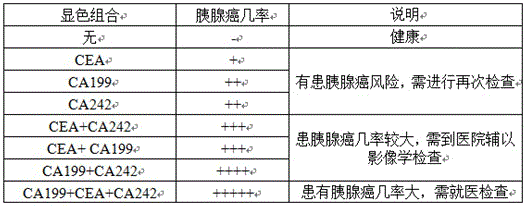Kit for dry-type fluorescent quantum dot joint detection diagnosis of pancreatic cancer
A fluorescent quantum dot and diagnostic kit technology, applied in the field of in vitro diagnostics, can solve the problems of unstable immune markers, time-consuming and labor-intensive, and low sensitivity
- Summary
- Abstract
- Description
- Claims
- Application Information
AI Technical Summary
Problems solved by technology
Method used
Image
Examples
Embodiment 1
[0036] Example 1 A dry fluorescent quantum dot joint detection diagnostic kit for pancreatic cancer
[0037] 1. Kit structure
[0038] 1.1 Kit composition
[0039] A dry-type fluorescent quantum dot joint detection diagnostic kit for pancreatic cancer comprises a test strip, a suction dropper, a sample diluent, a sample dilution cup and a storage medium.
[0040] 1.2 Structure of test strips
[0041] figure 1 Explain the structure of the test strip. figure 1 Among them, the pancreatic cancer quantum dot joint detection diagnostic reagent strip includes a sample pad 1 , a binding pad 2 , an NC membrane 3 , and a water-absorbing pad 4 which are sequentially overlapped on a special fluorescent substrate 5 .
[0042] The sample pad 1 of the test strip is a glass fiber membrane that can filter red blood cells. The bonding pad 2 is a glass fiber film or a polyester film. The NC membrane 3 has a detection line T1 (ie 31), a detection line T2 (ie 32), a detection line T3 (ie 33)...
Embodiment 2
[0051] Example 2 Kit detection method and evaluation criteria
[0052] Use the sample diluent to dilute the sample to be tested into the sample dilution cup, draw the diluent of the sample to be tested with a dropper and drop it onto the sample loading part of the test strip, wait for about 3 to 10 minutes, and wait for the sample to pass along the test strip. After chromatography, it was identified.
[0053] Qualitative or semi-quantitative detection: irradiate the reaction membrane area with a common excitation light source in the range of 320-450 nm to excite quantum dots, and identify it according to the fluorescence color of the corresponding antibody labeled with quantum dots, and detect from the absorbent pad to the sample pad respectively. The bands of CA19-9, CEA, and CA242 have corresponding fluorescent colors of green, orange, and red, and the quality control line near the end of the absorbent pad always has fluorescence. Then it can correspond to the probability o...
Embodiment 3
[0055] Example 3 Test paper standard curve establishment
[0056] (a) Take CA199, CEA, CA242 standard products to prepare a series of standard solutions with concentration gradients, as shown in Table 1, mix the No. 1 standard solution of standard solution CA199, CEA, CA242 evenly, mark it as B1, and prepare in the same way Standard solutions with series of concentration gradients labeled B2, B3, B4, B5, B6, B7, B8, B9, B10.
[0057] Standard solution category 1 2 3 4 5 6 7 8 9 10 CA199(U / mL) 1 5 10 50 100 250 500 1000 1500 2000 CEA (ng / mL) 0.3125 0.625 1.25 2.5 5 10 20 50 75 100 CA242(U / mL) 1 5 10 50 100 250 500 750 1000 1500
[0058] (b) Add the concentrations of 1-10 standard substances on 10 quantum dot immunochromatography test strips respectively, and use a detector to detect them under the same conditions (that is, use 10 quantum dot immunochromatography strips for each standard concentration The test...
PUM
 Login to View More
Login to View More Abstract
Description
Claims
Application Information
 Login to View More
Login to View More - R&D
- Intellectual Property
- Life Sciences
- Materials
- Tech Scout
- Unparalleled Data Quality
- Higher Quality Content
- 60% Fewer Hallucinations
Browse by: Latest US Patents, China's latest patents, Technical Efficacy Thesaurus, Application Domain, Technology Topic, Popular Technical Reports.
© 2025 PatSnap. All rights reserved.Legal|Privacy policy|Modern Slavery Act Transparency Statement|Sitemap|About US| Contact US: help@patsnap.com



